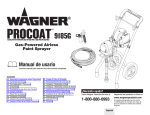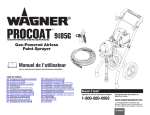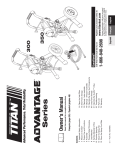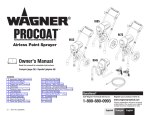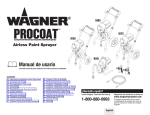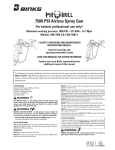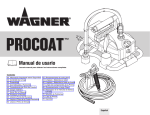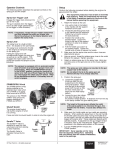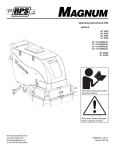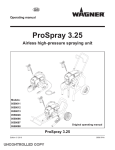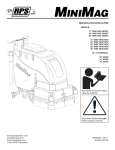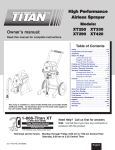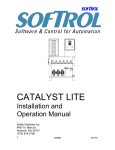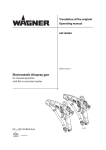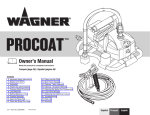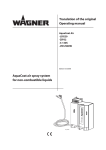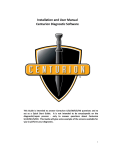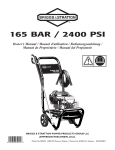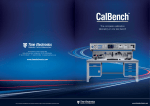Download English - Wagner
Transcript
PROCOAT 9185G ™ Gas-Powered Airless Paint Sprayer Owner’s Manual Read this manual for complete instructions Français (page 25) / Español (página 49) Contents 2 Important Safety Information 4 What’s in the Box? 5 Proper Use and Functions 6 Assembly 7 Pressure Relief Procedure 8 Load Material 9 Getting Material to Flow 10 Practice Spraying 12 Clear the Spray Tip 13 Clean the Spray Gun Filter 0412 • Form No. 0293922E 14 Clean the Inlet Filter 15 Short Term Storage 16 Cleanup - latex materials 18 Cleanup - oil-based materials 19 Cleaning the Spray Gun Components 20 Long-Term Storage 21 Cleaning the Sureflo™ Valve 22 Troubleshooting 72 Parts List 76 Warranty Questions? Call Wagner Technical Service at: Register your product online at: 1-800-880-0993 www.wagnerspraytech.com Español Proper registration will serve as proof of purchase in the event your original receipt becomes misplaced or lost. Français English Important Safety Safety Information Read all safety information before operating the equipment. Save these instructions Indicates a hazardous situation which, if not avoided, could result in death or serious injury. a) To reduce the risks of fire or explosion, electrical shock and the injury to persons, read and understand all instructions included in this manual. Be familiar with the controls and proper usage of the equipment. b) WARNING - To reduce the risk of fire or explosion: 1. Do not spray flammable or combustible materials near an open flame, pilot lights or sources of ignition such as hot objects, cigarettes, motors, electrical equipment and electrical appliances. Avoid creating sparks from connecting and disconnecting power cords. 2. Use extreme caution when using materials with a flashpoint below 70ºF (21ºC). Flashpoint is the temperature that a fluid can produce enough vapors to ignite. 3. Paint or solvent flowing through the equipment is able to result in static electricity. Static electricity creates a risk of fire or explosion in the presence of paint or solvent fumes. All parts of the spray system, including the pump, hose assembly, spray gun and objects in and around the spray area shall be properly grounded to protect against static discharge and sparks. Use only conductive or grounded high-pressure airless paint sprayer hoses specified by the manufacturer. 4. Verify that all containers and collection systems are grounded to prevent static discharge. 5. Connect to a grounded outlet and use grounded extension cords (electric models only). Do not use a 3 to 2 adapter. 6. Do not use a paint or solvent containing halogenated hydrocarbons. Such as chlorine, bleach mildewcide, methylene chloride and trichloroethane. They are not compatible with aluminum. Contact the coating supplier about compatibility of material with aluminum. English 7. Keep spray area well ventilated. Keep a good supply of fresh air moving through the area to keep the air within the spray area free from accumulation of flammable vapors. Keep pump assembly in well ventilated area. Do not spray pump assembly. 8. Do not smoke in the spray area. 9. Do not operate light switches, engines, or similar spark producing products in the spray area. 10. Keep area clean and free of paint or solvent containers, rags, and other flammable materials. 11. Know the contents of the paint and solvents being sprayed. Read all Material Safety Data Sheets (MSDS) and container labels provided with the paints and solvents. Follow the paint and solvent manufacture’s safety instructions. 12. Place pump at least 25 feet (7.62 meters) from the spray object in a well ventilated area (add more hose if necessary). Flammable vapors are often heavier than air. Floor area must be extremely well ventilated. The pump contains arcing parts that emit sparks and can ignite vapors. 13. Plastic can cause static sparks. Never hang plastic to enclose spray area. Do not use plastic drop cloths when spraying flammable material. 14. Fire extinguisher equipment shall be present and working. c) WARNING - To reduce the risk of skin injection: 1. Do not aim the gun at, or spray any person or animal. 2. Keep hands and other body parts away from the discharge. For example, do not try to stop leaks with any part of the body. 3. Always use the nozzle tip guard. Do not spray without the nozzle tip guard in place. 4. Only use a nozzle tip specified by the manufacturer. 5. Use caution when cleaning and changing nozzle tips. In the case where the nozzle tip clogs while spraying, ALWAYS lock gun trigger, shut pump off, and release all pressure before servicing, cleaning tip or guard, or changing tip. Pressure will not be released by turning off the motor. The PRIME/SPRAY valve or pressure bleed valve must be turned to their appropriate positions to relieve system pressure. Refer to PRESSURE RELIEF PROCEDURE described in the pump manual. 6. Do not leave the unit energized or under pressure while unattended. When the unit is not in use, turn off the unit and relieve the pressure in accordance with the manufacturer’s instructions. 7. High-pressure spray is able to inject toxins into the body and cause serious bodily injury. In the 2 8. 9. 10. 11. 12. 13. event that injection occurs, seek medical attention immediately. Check hoses and parts for signs of damage, a leak can inject material into the skin. Inspect hose before each use. Replace any damaged hoses or parts. This system is capable of producing 3000 PSI / 207 Bar. Only use replacement parts or accessories that are specified by the manufacturer and that are rated a minimum of 3000 PSI. This includes spray tips, nozzle guards, guns, extensions, fittings, and hose. Always engage the trigger lock when not spraying. Verify the trigger lock is functioning properly. Verify that all connections are secure before operating the unit. Know how to stop the unit and bleed pressure quickly. Be thoroughly familiar with the controls. Pressure will not be released by turning off the motor. The PRIME/SPRAY valve or pressure bleed valve must be turned to their appropriate positions to relieve system pressure. Refer to PRESSURE RELIEF PROCEDURE described in the pump manual. Always remove the spray tip before flushing or cleaning the system. NOTE TO PHYSICIAN: Injection into the skin is a traumatic injury. It is important to treat the injury as soon as possible. DO NOT delay treatment to research toxicity. Toxicity is a concern with some coatings injected directly into the blood stream. Consultation with a plastic surgeon or reconstructive hand surgeon may be advisable. d) WARNING - To reduce the risk of injury: 1. Always wear appropriate gloves, eye protection, clothing and a respirator or mask when painting. Hazardous vapors – Paints, solvents, insecticides, and other materials can be harmful if inhaled or come in contact with body. Vapors can cause severe nausea, fainting or poisoning. 2. Wear ear protection. This unit can produce noise levels above 85 dB(A). 3. Do not operate or spray near children. Keep children away from equipment at all times. 4. Do not overreach or stand on an unstable support. Keep effective footing and balance at all times. 5. Stay alert and watch what you are doing. 6. Do not operate the unit when fatigued or under the influence of drugs or alcohol. 7. Do not kink or over-bend the hose. Airless hose can develop leaks from wear, kinking and abuse. A leak can inject material into the skin. 8. Do not expose the hose to temperatures or pressures in excess of those specified by manufacturer. 9. Do not use the hose as a strength member to pull or lift the equipment. 10. Use lowest possible pressure to flush equipment. 11. Follow all appropriate local, state and national codes governing ventilation, fire prevention and operation. 12. The United States Government Safety Standards have been adopted under the Occupational Safety and Health Act (OSHA). These standards, particularly part 1910 of the General Standards and part 1926 of the Construction Standards should be consulted. 13. Before each use, check all hoses for cuts, leaks, abrasion or bulging of cover. Check for damage or movement of couplings. Immediately replace hose if any of those conditions exist. Never repair a paint hose. Replace with a conductive high-pressure hose. 14. Do not spray outdoors on windy days. 15. Always unplug cord from outlet before working on equipment (electric models only). Gasoline Engine Safety • • • • • • • The engine exhaust from this unit contains chemicals known to the State of California to cause cancer, birth defects, or other reproductive harm. Gas engines are designed to give safe and dependable service if operated according to instructions. Read and understand the engine Owner’s Manual before operating the engine. Failure to do so could result in personal injury or equipment damage. To prevent fire hazards and to provide adequate ventilation, keep the engine at least 1 meter (3 feet) away from buildings and other equipment during operation. Do not place flammable objects close to the engine. To prevent fire or explosion hazard, avoid spraying or splashing any flammable solvent near the engine. Children and pets must be kept away from the area of operation due to a possibility of burns from hot engine components or injury from any equipment the engine may be used to operate. Know how to stop the engine quickly, and understand the operation of all controls. Never permit anyone to operate the engine without proper instructions. Gasoline is extremely flammable and is explosive under certain conditions. Refuel in a well-ventilated area with the engine stopped. Do not smoke or allow flames or sparks in the refueling area or where gasoline is stored. • Do not overfill the fuel tank. After refueling, make sure the tank cap is closed properly and securely. • Be careful not to spill fuel when refueling. Fuel vapor or spilled fuel may ignite. If any fuel is spilled, make sure the area is dry before starting the engine. • Never run the engine in an enclosed or confined area. Exhaust contains poisonous carbon monoxide gas; exposure may cause loss of consciousness and may lead to death. • The muffler becomes very hot during operation and remains hot for a while after stopping the engine. Be careful not to touch the muffler while it is hot. To avoid severe burns or fire hazards, let the engine cool before transporting it or storing it indoors. • Never ship/transport unit with gasoline in the tank. • Never dispose of the unit when it is filled with oil or gas. Follow all appropriate local, state, and national regulations when disposing of the unit. Safety Shut-Off Switch The safety shut-off switch is pre-set by the factory to shut down the sprayer to prevent over-pressurization. Do not attempt to adjust or tamper with the safety shutoff switch. Contact an authorized service center if this setting requires adjustment. NOTE: The safety shut-off switch should be set to shut down the sprayer between 3200 – 3300 PSI. Fueling (gas engine) Gasoline is extremely flammable and is explosive under certain conditions. • ALWAYS turn the engine off before refueling. • Refuel in a well-ventilated area. • Do not smoke or allow flames or sparks in the refueling area or where gasoline is stored. • Do not overfill the fuel tank. After refueling, make sure the tank cap is closed properly and securely. • Be careful not to spill fuel when refueling. Spilled fuel or fuel vapor may ignite. If any fuel is spilled, make sure the area is dry before starting the engine. • Avoid repeated or prolonged contact with skin or breathing of vapor. • Keep out of the reach of children. Fuel Specifications • Use automotive gasoline that has a pump octane number of 86 or higher, or that has a research 3 octane number of 91 or higher. Use of a lower octane gasoline can cause persistent “pinging” or heavy “spark knock” (a metallic rapping noise) which, if severe, can lead to engine damage. NOTE: If “spark knock” or “pinging” occurs at a steady engine speed under normal load, change brands of gasoline. If spark knock or pinging persists, consult an authorized dealer of the engine manufacturer. Failure to do so is considered misuse, and damage caused by misuse is not covered by the engine manufacturer’s limited warranty. NOTE: Occasionally you may experience light spark knock while operating under heavy loads. This is no cause for concern, it simply means your engine is operating efficiently. • Unleaded fuel produces fewer engine and spark plug deposits and extends the life of the exhaust system components. • Never use stale or contaminated gasoline or an oil/ gasoline mixture. Avoid getting dirt, dust, or water in the fuel tank. Gasolines Containing Alcohol If you decide to use a gasoline containing alcohol (gasohol), be sure its octane rating is at least as high as that recommended by the engine manufacturer. There are two types of “gasohol”: one containing ethanol, and the other containing methanol. Do not use gasohol that contains more than 10% ethanol. Do not use gasoline containing methanol (methyl or wood alcohol) that does not also contain co-solvents and corrosion inhibitors for methanol. Never use gasoline containing more than 5% methanol, even if it has co-solvents and corrosion inhibitors. NOTE: Fuel system damage or engine performance problems resulting from the use of fuels that contain alcohol is not covered under the warranty. The engine manufacturer cannot endorse the use of fuels containing methanol since evidence of their suitability is incomplete at this time. Before buying gasoline from an unfamiliar station, try to find out if the gasoline contains alcohol. If it does, confirm the type and percentage of alcohol used. If you notice any undesirable operating characteristics while using a gasoline that contains alcohol, or one that you think contains alcohol, switch to a gasoline that you know does not contain alcohol. English GS-07 Spray Gun Assembly What’s in the box?* Sprayer Assembly Hose wrap Engine *Certain parts of the sprayer will not be assembled out of the box. Be sure to read Assembly instructions, page 6. Start DirectLink™ pressure control knob AutoOiler™ cap Notice: Refer to the engine manufacturer’s instruction manual for complete engine information. Heed all cautions and warnings. VersaTip™ Spray Tip Assembly Note: The engine on the sprayer will come filled with oil. However, it is still a good idea to check it prior to startup. The engine has sufficient oil when you can see it just below the opening in the oil reservoir when the oil cap (a) is removed. Spray tip Grounding cable Spray hose port (reverse side) Cart knob (2) Pump cleaning adapter Shutoff switch AutoOiler™ button Spray guard PRIME/SPRAY knob Pail bracket Spray Hose Assembly (50 ft) Sureflo™ valve Suction tube Material return tube (a) Inlet filter Starting the engine: Follow these steps to start the engine when it is “cold”, or has not been recently running. If the engine is “warm”, follow step 3 only. important: Do not pull starter cord to full extension. Doing so may result in damage to the engine recoil, and is not necessary to start this engine. English 1 (a) 1. Make sure the gas tank is full. Move the choke lever (a) up to the full choke position. 2 3 4 (c) (b) (d) 2. Push the rubber prime button (b) 7-10 times. 4 3. Pull the starter rope (c) rapidly and firmly. Continue to hold the rope as you let it return. Pull and return the rope until the engine starts. 4. Once the engine is running, slowly move the choke lever (d) down to the closed position. DirectLink™: PRIME/SPRAY knob: SPRAY PRIME Proper use and functions Controls and Functions Spraying pressure is determined by the motor throttle. The throttle is regulated by adjusting the DirectLink™ pressure control knob. The higher the throttle, the higher the spraying pressure. The PRIME/SPRAY knob directs material to the material return tube when set to PRIME or to spray hose when set to SPRAY. Spray hose: Capability: The spray hose connects the spray gun to the pump. Sprays a variety of paints (oil-based and latex), primers, stains, preservatives and other nonabrasive materials. Do not use. . . This pump should not be used with textured materials, block filler, asphalt sealer or materials containing HHC. See coating supplier if flash point is not listed on the container NARROW Start WIDE Specifications: Power���������������������������������Ruitao 37.7 cc engine, 1.6 Hp Gas capacity�����������������������0.65 l (approximately 1 hour spraying time) Oil capacity�������������������������0.08 l Maximum pressure�������������3000 PSI Flow rate�����������������������������0.33 gal/min (1.25 l) Max tip size������������������������0.017” The spray gun controls the delivery of the material being pumped. GS-07 Trigger lock: Engage the trigger lock whenever the gun is not in use. GS-07 - The gun is locked when the trigger lock is at a 90º angle (perpendicular to the trigger in either direction). AutoOiler: The AutoOiler is designed to provide lubrication to the fluid section of the pump. Sureflo Valve: The Sureflo Valve is designed to keep the inlet valve open and from sticking to dried materials. The Sureflo Valve is activated manually by the user. Suction tube (a): The suction tube draws the fluid from the original container into the pump. Material return tube (b): Collapsible handle: Burn hazard. When collapsed, the cart handle is very close to the exhaust port of the engine, which can be very hot after use. It is recommended that the cart handle NOT be collapsed until after the engine has cooled. The VersaTip spray tip can be adjusted based on your spraying needs. Spray gun: Safety features: Spray gun trigger lock and pressure diffuser; built-in tip safety guard; PRIME/SPRAY knob for safe pressure release. VersaTip spray tip: The cart handle can be collapsed for easier storage. Turn the cart knobs counterclockwise to unlock the handle. Turn the cart knobs clockwise to lock the handle into place. 5 (a) (b) Fluid is sent out through the return tube and back into the original container when the PRIME/SPRAY knob is in the PRIME position. English 1. Assembly Start 1 2 3 You will need: • Two adjustable wrenches Note: It will be much easier to attach the hose to the sprayer if you uncoil it first. 1. Insert the ends of the hose bracket into the holes of the handle as shown. English 2. Remove the plug from inside the hose fittings and remove the cap on the outlet valve. Discard both. 4 5 4. Hold the port with an adjustable wrench, and tighten the hose with the other. 5. Thread the other end of the hose to the spray gun. Hold the gun with one adjustable wrench, and tighten the hose nut with the other. 6 3. Thread one end of the high pressure spray hose to the spray hose port. Pressure Safety Relief Procedure* *Perform when instructed Start Important Safety Warning Be careful when handling the spray gun so you don’t accidently spray yourself. The high pressure paint stream could pierce your skin causing serious injury. If an accident happens see detail procedures in the Safety Information section on pages 2-3. See physician immediately and bring this instruction manual. 1 2 3 1. Lock the spray gun. 2. Turn the DirectLink pressure control knob to minimum. 3. Turn the PRIME/SPRAY knob to PRIME. Important Safety Warning You will need: • A waste bucket SPRAY 4 5 4. Press and hold the red engine shutoff switch until the engine stops running. 7 5. Unlock the spray gun. Briefly pull the trigger to fully relieve pressure from the system. Lock the spray gun. English PRIME Be sure to follow the Pressure Relief Procedure when shutting the unit off for any purpose. This procedure is used to relieve pressure from the spray hose. Failure to do so could result in serious injury. 2. Load Material Start • • • • 1 2 3 (a) You will need: The material you plan to spray Flat blade screwdriver Piston Oil™ Waste bucket 1. Remove AutoOiler cap with a flat blade screwdriver. Squirt Piston Oil into the AutoOiler. Replace cap. 5 (a) 3. Fully depress the Sureflo valve to make sure the inlet ball is free. 6 7 8 6. Attach the supplied grounding wire to a grounded object. Start the engine (see directions on page 4). 7. Increase the pressure to maximum (+). Allow pump to run until you see spray material flowing from the return tube. 8. Shut the engine off. Place return tube back into material container and clip return tube and suction tube together. PRIME SPRAY 4 2. Push AutoOiler button 2-5 times to lubricate the fluid section. Press button 2-3 times before every use. Be sure to check reservoir level (a) and refill as necessary. (b) 4. Place a full container of spraying material underneath the suction tube (a). Hold the return tube into a waste container (b). English 5. Turn the PRIME/SPRAY knob to PRIME. 8 2 3 4 SPRAY SPRAY PRIME Start 1 PRIME 3. Getting Material to Flow You will need: • Waste bucket • Scrap material / cardboard • Drop cloths to protect floors and furnishings from overspray IMPOR´TANT: When placed on a smooth surface, the vibration of the running engine may cause the unit to move forward or backward slightly. Avoid placing the unit on an inclinded surface or near a drop-off such as stairs. Block the wheels to prevent the unit from moving. 5 1. Start the engine (see page 4). Point the spray gun into a separate waste container. Unlock the spray gun trigger. Squeeze and hold trigger for steps 2-3. 2. Turn the PRIME/SPRAY knob to SPRAY. 6 3. Continue to squeeze trigger until the material is flowing freely through the spray gun. 7 4. Peform the Pressure Relief Procedure, page 7. 8 SPRAY OR SPRAY PRIME 5. Thread the spray tip guard assembly onto the gun. Tighten by hand. 6. Rotate spray tip forward to one of the SPRAY positions. Unlock the spray gun trigger. 7. Start the engine (see directions on page 4). Turn the PRIME/SPRAY knob to SPRAY. 9 8. Point the spray gun at a piece of scrap material/cardboard. Pull the trigger and practice spraying (see pages 10-11). English 4. Practice Spraying Start Tip: Trigger gun after starting the stroke. Release the trigger before ending the stroke. The spray gun should be moving when the trigger is pulled and released. Overlap each stroke by about 50%. This will ensure an even coating. You will need: • Scrap material / cardboard Notes: If the spray pattern becomes distorted or stops completely while the gun is triggered, follow any or all the procedures listed on pages 12-14. If you plan to be away from your spray project for more than one hour, follow the Short Term Storage instructions on page 15. If you have difficulty achieving a good spray pattern, your spray tip and gun filter may not be ideal for the type of material you are spraying. Spray Tip Size Filter Color Spray Material Initial Pressure Setting 311 Red Thin stains, sealers Minimum Yellow Latex paints, stains Maximum White Thick latex paints, stains Maximum Practice on a piece of scrap material/cardboard Hold the Spray Gun Level correct incorrect 313 413 415 515 517 English 10” - 12” 10” - 12” (25 - 30 cm) (25 - 30 cm) 10 Spray Technique Tip: correct Flex your wrist as you move in order to keep gun parallel to the surface correct inCorrect Start stroke Pull trigger Move steadily Release trigger End stroke Spray Pattern Overlap Your Strokes GOOD SPRAY PATTERN BAD SPRAY PATTERN: TAILING 50% Overlap 8” - 10” (20 - 25 cm) ! correct See page 12-14 11 English Spraying Troubleshooting - 1 2 Clear the Spray Tip Start You will need: Note: If spray tip is difficult to rotate, relieve pressure by 1) slowly turn PRIME/ SPRAY knob to PRIME, 2) unlock the spray gun and 3) squeeze trigger while pointing at scrap material/ cardboard. Release trigger, lock the spray gun, and try rotating spray tip again. • Scrap material / cardboard Do not attempt to unclog or clean the tip with your finger. High pressure fluid can cause injection injury. OR 1. Lock the spray gun. 2. Rotate spray tip 180 degrees from its current position. 4 3 5 NARROW SPRAY OR PRIME 3. Make sure the PRIME/ SPRAY knob is turned to SPRAY. Unlock the spray gun. English WIDE 4. Point at a piece of scrap material / cardboard and squeeze trigger until material comes out in a high pressure stream. Release the trigger and lock the spray gun. 12 5. Rotate spray tip forward to one of the SPRAY positions. Unlock the spray gun and resume spraying. Spraying Troubleshooting - 1 Start • • • • SPRAY 3 PRIME Clean the Spray Gun Filter 2 You will need: Wrench Warm, soapy water for latex material Mineral spirits for oil based materials Replacement spray gun filter (if necessary) important: Never clean the filter by poking it with a sharp object. (a) 1. Peform the Pressure Relief Procedure, page 7. 2. Pull trigger guard from filter housing. 3. Tighten the wrench over the wrench flats (a). Unscrew the filter housing using a wrench. Note: You DO NOT need to remove the spray hose from the gun to clean the filter. 4 4. Remove the filter from the housing. Clean with appropriate cleaning solution (warm, soapy water for latex materials; mineral spirits for oil-based materials). 5 6 6. Replace cleaned filter, tapered end first, into the gun housing. Note: It is important to place tapered end first to ensure proper sprayer operation. 5. Inspect the filter for damage. Replace if any holes or tears are found. 13 7 7. Reassemble the spray gun. English Spraying Troubleshooting - 1 2 Clean the Inlet Filter Start You will need: • Warm, soapy water for latex material • Mineral spirits for oil based materials important: Make sure your floors and furnishings are covered with drop cloths to prevent accidental drips. 1. Unscrew the inlet filter from the fitting on the end of the suction tube. 2. Clean the filter using the appropriate cleaning solution (warm, soapy water for latex materials, mineral spirits for oil-based materials). 3 Note: If after completing all of the steps in Spraying Troubleshooting you are still experiencing problems spraying, refer to the Troubleshooting section (page 22). 3. Replace the cleaned filter by threading it back into the fitting on the end of the suction tube. English 14 Start • • • • 2 SPRAY 1 3 PRIME Short Term Storage Shutdown You will need: OR Water Plastic bag or bucket Rags Stir stick This procedure should be used when taking a short term break or when ending your project for the day. If your break is longer than 16 hours follow Cleanup instructions, page 16. Instructions are for latex materials only Note: If using oil based material follow instructions for Cleanup on page 16. 1. Peform the Pressure Relief Procedure, page 7. 2. Place spray gun in plastic bag or immerse into bucket of water. 3. Pour 1/2 cup water slowly on the top of the paint to prevent the paint from drying. Place the entire spraying system out of the sun. Startup 1 2 3 Page 9 1. Remove the spray gun from the plastic bag or the water. 15 2. If water was added during shut down, stir water into material with the stir stick. 3. Follow Getting Material to Flow instructions, page 9. English Cleanup MINERAL SPIRITS Start Cleaning notes - read before cleaning • When using latex material, clean sprayer and components with warm, soapy water. For oil based material use mineral spirits. Never use mineral spirits with latex materials. • NEVER use gasoline to clean sprayer. • Dispose of used cleaning solution properly. • Thorough cleaning and lubrication of sprayer is important to ensure proper operation after storage. • If you flush your sprayer with mineral spirits, repeat Cleanup instructions using warm, soapy water. or You will need: Follow these steps whenever cleaning with mineral spirits: • If spraying or cleaning with oil-based materials, the spray gun must be grounded while preparing the spray hose or cleaning. • Ground the gun by holding it against the edge of a metal container while purging. Failure to do so may lead to a static electric discharge which may cause a fire. • Always flush spray gun at least one hose length from spray pump. • If collecting flushed solvent in one gallon metal container, place it into an empty five gallon container, then flush. • Area must be free from vapors. • Follow all cleanup instructions. • A water source that can be delivered with a garden hose (latex materials only) • Mineral spirits if using oil-based material • Empty waste container • A container with warm, soapy water Cleanup - Latex materials STOP Follow these steps if you used latex materials and if you have a garden hose available. If you do not have a garden hose available, follow the Cleanup - Oil-Based Materials instructions on page 18. 2 1. Perform Pressure Relief Procedure (page 7). 3 4 PRIME SPRAY 1 English 2. Remove the spray tip and place into container filled with warm, soapy water. 3. Place the suction tube and return tube into an empty waste container. 16 4. Using a garden hose, rinse off the suction tube, return tube and inlet filter. Empty the waste container of all fluids. 6 7 8 6. Thread pump cleaning adapter onto garden hose. Thread suction tube fitting over the adapter. 9 10 7. Unclip the return tube from the suction tube and place it into the waste container. Turn the PRIME/SPRAY knob to PRIME. SPRAY 8. Turn the water supply to the garden hose on. Start the engine (see page 4). Water will go into the suction tube and out through the return tube. Let the pump run for a few minutes, and leave pump running for next steps. 12 11. Continue squeezing the trigger until fluid is coming out clear. 12. Perform Pressure Relief Procedure, page 7. PRIME 9. Point the spray gun at the side of a waste container. 10. While squeezing the trigger, turn the PRIME/SPRAY knob to SPRAY. PRIME 11 SPRAY 5. Remove the inlet filter from the suction tube and place it into waste container. PRIME SPRAY 5 Move on the Cleaning the Spray Gun Components, page 19. 17 English Cleanup Oil-Based Materials SPRAY 2 3 PRIME Start 1 You will need: • Mineral spirits if using oil-based material • Warm, soapy water if using latex material • Waste container 4 1. Perform Pressure Relief Procedure (page 7). 5 2. Remove the spray tip and place into an empty waste container. 6 3. Attach the supplied grounding wire to a grounded object. Submerge suction set into a bucket with the appropriate cleaning solution. 7 SPRAY PRIME SPRAY Follow these steps if you sprayed oil-based materials, or if you sprayed latex materials and do not have a garden hose available. Be sure to use the appropriate cleaning solution for the type of material sprayed. PRIME 4. Start the engine (see instructions on page 4). Point the spray gun at the side of a waste container. Ground the gun against the side of a metal waste container if flushing with mineral spirits. English 5. While squeezing the trigger, turn the power ON, and turn the PRIME/ SPRAY knob to SPRAY. 6. Continue squeezing the trigger until fluid is coming out clear. You may need to get new cleaning solution. 18 7. Perform Pressure Relief Procedure, page 7. If you flushed the sprayer with mineral spirits repeat the steps on this page using warm, soapy water. Cleaning the Spray Gun Components • • • • • SPRAY 2 3 PRIME Start 1 You will need: Soft bristled brush Light household oil Warm, soapy water if using latex material Mineral spirits for oil based material Wrench (a) 1. Peform the Pressure Relief Procedure, page 7. important: DO NOT use any siliconebased lubricants to clean or lubricate the spray gun. 4 5 2. Pull trigger guard to separate from filter housing and unscrew housing using a wrench. Note: Tighten the wrench over the wrench flats (a). 6 3. Remove filter from spray gun. Clean spray tip and filter with soft bristled brush and appropriate cleaning solution. 7 (b) HOUSEHOLD OIL 4. Pour a few drops of light household oil inside gun housing. (c) 5. Install gun filter taperedend first. Reassemble spray gun. 6. Line up the tabs (b) on the spray tip with the slots in the guard assembly. Slide the tip into the guard. 19 7. Install spray tip and guard assembly. Move on to Long Term Storage, page 20. English Start OIL 2 SE HO U 1 D HO L Long Term Storage You will need: • Light household oil / Piston Oil • Rags • Wrench important: Store in a well-ventilated area. If you plan to store in temperatures below 32ºF (0ºC), flush with Wagner Liquid Shield™ (sold separately). HOUSEHOLD OIL 1. Remove the suction tube. Using a wrench, remove the spray hose. 3 2. Fill a cup or other container with two ounces of Piston Oil (light household oil can be substituted). Start the engine (see directions on page 4). 4 5 4. Replace suction tube. 5. Wipe entire unit, hose, and spray gun to remove accumulated spray material. (a) 3. Cover the outlet valve with a rag. Submerge the Sureflo™ valve (a) into the oil. When oil has been sucked from the cup, press and hold the engine shutoff button until the engine stops running. English 20 Cleaning the Sureflo Valve Start 1 2 You will need: (a) • Wrench Cleaning or servicing the Sureflo Valve may be required if the unit has priming problems. Priming problems may be prevented by properly cleaning the sprayer and following the long-term storage steps. 1. Remove the suction tube. 2. Unscrew the Sureflo Valve assembly (a) from the sprayer. Visually inspect the inside and outside of the Sureflo Valve assembly. Clean any paint residue with the appropriate cleaning solution. If priming problems persist, you may need to replace the Sureflo Valve assembly. Call Technical Service (1-800-880-0993) to order new Sureflo valve assembly. 3 4 (b) 3. Lubricate the O-ring on the Sureflo Valve (b) with petroleum jelly. Replace Sureflo Valve assembly by screwing it into the sprayer. Tighten with the wrench. 21 4. Replace suction tube and hand-tighten. English Troubleshooting Before servicing, always release system pressure by following Pressure Relief Procedure (page 7). Problem A: The sprayer does not start 1. 2. Cause Gas tank is empty There is a problem with sprayer engine Solution Fill the gas tank Call Technical Service Problem B: The sprayer starts but does not draw material when the PRIME/SPRAY knob is set to PRIME 1. Cause The inlet valve is stuck 2. 3. 4. 5. 6. 7. 8. The sprayer will not prime properly or has lost prime The suction set is not properly installed The material container is empty The inlet filter is clogged The outlet valve is stuck The inlet valve is worn or damaged The PRIME/SPRAY valve is plugged Solution Inlet may be stuck from old material. Push Sureflo Valve to release. If still stuck refer to Clean the Inlet Filter see page 14 or Cleaning the Sureflo™ Valve see page 21 * Refer to Getting Material to Flow section see page 9 Reinstall the suction set see page 6 Refer to Load Material and Getting Material to Flow sections see pages 8-9 Refer to Clean the Inlet Filter see page 14 Call Technical Service Take sprayer to Wagner Authorized Service Center Take sprayer to Wagner Authorized Service Center Problem C: The sprayer draws up material but the pressure drops when the gun is triggered (bad spray pattern) 1. 2. 3. 4. 5. 6. 7. Cause Pressure too low The spray tip is worn The inlet filter is clogged The spray tip is plugged The spray gun filter is clogged The material is too heavy or coarse The Sureflo™ Valve assembly is damaged or worn Solution Increase the pressure Replace spray tip with a new one** Refer to Clean the Inlet Filter see page 14 Refer to Clear the Spray Tip see page 12 Refer Clean the Spray Gun Filter see page 13. Keep extra filters on hand Thin or strain the material Replace the Sureflo Valve see page 21* Problem D: The PRIME/SPRAY knob is set to SPRAY and there is flow through the material return tube 1. Cause The PRIME/SPRAY valve is dirty or worn Solution Take sprayer to Wagner Authorized Service Center Problem E: The spray gun leaks 1. 2. Cause Gun filter housing is loose Internal parts of spray gun are worn or dirty English Solution Tighten handle Take sprayer to Wagner Authorized Service Center 22 Problem F: The spray tip assembly leaks 1. 2. Cause The spray tip was assembled incorrectly Gun seal is worn Solution Check tip assembly and assemble properly see page 19, steps 6-7 Replace the seal** Problem G: The spray gun will not spray 1. 2. 3. 4. Cause The spray tip plugged The spray gun filter is clogged The spray tip is in wrong position PRIME/SPRAY knob not set on SPRAY Solution Refer to Clear the Spray Tip see page 12 Refer to Clean the Spray Gun Filter see page 13. Keep extra filters on hand Rotate spray tip to one of the spraying positions see page 12, step 5 Turn PRIME/SPRAY knob to SPRAY see page 9 Getting Material to Flow Problem H: The spray pattern is poor (tailing) 1. 2. 3. 4. 5. 6. 7. Cause Pressure too low The spray tip is plugged The inlet filter is clogged The spray gun filter is clogged The spray tip is worn The material is too thick Pressure loss Solution Increase the pressure Refer to Clear the Spray Tip see page 12 Refer to Clean the Inlet Filter see page 14 Refer to Clean the Spray Gun Filter see page 13. Keep extra filters on hand Replace the spray tip Thin material using appropriate thinning solution Refer to Causes and Solutions for Problem C Problem I: The spray tip will not turn 1. Cause High pressure has locked the spray tip in place Solution Refer to Clear the Spray Tip see page 12 ** Additional parts are available for this procedure. Refer to the Parts List (page 74) section of this manual for a list of the parts and their part numbers Daily Maintenance The only daily maintenance necessary is thorough cleaning. Follow the cleaning procedures in this manual. Extended Maintenance Some pump parts eventually wear out from use and must be replaced. The following is a list of available repair kits. Pump performance is the only reliable indicator of when to replace wear parts. Refer to the Troubleshooting section for more information on when to use these kits 23 Kit Part # Description 0512178A 0501014 Fluid Section Seal Kit Saddle seat/seal kit English Parts List • Liste de Pièces • Lista de Piezas Sprayer • Pulvérisateur • Rociador 1 2 3 Item Art. Art. Part No. No de piéce Pieza No. English - Description Français - Description Español - Descripción 1 0293198A Cart assembly Ensemble du chariot Ensamblaje de carrito 1 2 0523320A Hose wrap Support du flexible Soporte de manguera 1 3 0516581A AutoOiler cap Capuchon de AutoOiler Tapa de AutoOiler 1 4 0270118 Spray hose, 50’ Flexible de pulvérisation, 15 m Manguera del rociador, 15 m 1 730-165 Grounding wire Câble de mise à la terre Cable de conexión a tierra 1 4 This unit contains no servicable parts. Do not attempt to service yourself. Take the sprayer to a Wagner authorized service center. Cet appareil ne contient aucune pièce nécessitant un entretien quelconque. Ne tentez pas d’effectuer vous-même l’entretien. Apporter l’appareil à un centre de service autorisé Esta unidad no contiene piezas que se puedan reparar. No intente repararlas personalmente. Lleve el rociador a un Centro de servicio autorizado de Wagner. English Français Español 72 Qty. Qté. Cant. Parts List • Liste de Pièces • Lista de Piezas Suction set • Dispositif d’aspiration • Juego de succión 5 6 1 2 3 Item Art. Art. Part No. No de piéce Pieza No. 1 0516127 English - Description Français - Description Español - Descripción Suction set Dispositif d’aspiration Juego de succión 1 2 0512389 Return tube Tube de retour Tubo de retorno 1 3 0512390 Clip Agrafe Abrazadera 1 4 0552947 Inlet filter Filtre d’entrée Filtro de entrada 1 5 0327226 Squeeze clip Agrafe de compression Abrazadera del apretón 1 6 9885553 Return tube fitting Raccord de tube de retour Conector del tubo de retorno 1 7 0515146 Pump cleaning adapter Adaptateur de nettoyage de pompe Adaptador de limpieza de bomba 1 7 4 Qty. Qté. Cant. 73 Español Español Français English Parts List • Liste de Pièces • Lista de Piezas GS-07 Spray Gun • Pistolet de GS-07 • Pistola de GS-07 3 4 Item Art. Art. Part No. No de piéce Pieza No. English - Description Français - Description Español - Descripción 1 0511515 VersaTip, 515 VersaTip, 515 VersaTip, 515 1 2 0154675 Filter, 100 mesh (yellow, 2 pack) Filtre, maille 100 (jaune, trousse de 2) Filtro, malla 100 (amarillo, juego de 2) 1 3 0515228 Seal Joint d’etanchéite Sello 1 Filter housing Logement de filtre Alojamiento de filtro 1 Swivel Raccord Giratoria 1 4 ------ 5 0347706A Qty. Qté. Cant. 2 1 5 Guard Assembly • Ensemble de déflecteur • Ensamblaje del protección 1 4 2 5 3 English Français Español Item Art. Art. Part No. No de piéce Pieza No. 1 2 Qty. Qté. Cant. English - Description Français - Description Español - Descripción 0271441 Hook guide Guide de crochet Guía de gancho 1 0501011 Guard assembly Déflecteur Ensamblaje de protección 1 3 0271442 Latch guide Guide de verrou Guía de sujetador 1 4 0501014 Tip seal / saddle seat Joint de buse / siège formé Junta de boquilla / asiento de la montura 1 5 0296641 Collar Collier Collar 1 0271065 Collar kit (includes items 1, 3 and 5) Trousse de bague (comprende les articles 1, 3 et 5) Juego de collar (incluye los articulos 1, 3 y 5) 74 Accessories • Accessoires • Accesorios Part No. No de piéce Pieza No. 0512178A 0093896 0501011 0501014 0501411 0501413 0501415 0501417 0501419 0501515 0501517 0511313 0511515 0511517 0154839 0516913 0297055 0508071 0286024 0286025 0270192 0523044 0270118 0291004 0154919 0154675 0154842 0512132W 0512131W 0512130W 0156113 0155208 0155206 0516697A English - Description Piston repair kit Hose connector kit Tip guard Tip seat / seal kit 411 Spray Tip 413 Spray Tip 415 Spray Tip 417 Spray Tip 419 Spray Tip 515 Spray Tip 517 Spray Tip 313 VersaTip spray tip 515 VersaTip spray tip 517 VersaTip spray tip All Guard Protector (32 oz.) Piston Oil™ Pump Shield™ (12 oz.) Paint Mate™ (1 qt) GS-07 spray gun GS-08 spray gun Airless hose, 25’ x 1/4” Airless hose, 35’ x 1/4” Airless hose, 50’ x 1/4” Hose, whip end, 3’ x 3/16” Green gun filter, coarse (2 pack) Yellow gun filter, fine (2 pack) White gun filter, medium (2 pack) Tip extension, 36” Tip extension, 24” Tip extension, 12” TR-10 telescoping roller, 3/8” nap Roller cover, 3/4” nap Roller cover, 3/8” nap Inlet filter Français - Description Jeu de joints pour tronçon d’acheminement Raccord de flexible Déflecteur Trousse de siège / rondelle Embout de pulvérisation, 411 Embout de pulvérisation, 413 Embout de pulvérisation, 415 Embout de pulvérisation, 417 Embout de pulvérisation, 419 Embout de pulvérisation, 515 Embout de pulvérisation, 517 Buse de pulvérisation VersaTip, 313 Buse de pulvérisation VersaTip, 515 Buse de pulvérisation VersaTip, 517 All Guard Protector (950 ml) Piston Oil™ Pump Shield™ (12 oz.) Paint Mate™ (1 L) Modèle du pistolet GS-07 Modèle du pistolet GS-08 Flexible sans air, 7,6 m x 0,6 cm Flexible sans air, 10,6 m x 0,6 cm Flexible sans air, 15 m x 0,6 cm Flexible sans air, 1 m x 0,5 cm Filtre de pistolet, vert, grossier (2 pièces) Filtre de pistolet, jaune, fin (2 pièces) Filtre de pistolet, blanc, moyen (2 pièces) Rallonge de buse, 36 pi Rallonge de buse, 24 pi Rallonge de buse, 12 pi Rouleau téléscopique de TR-10, grain de 1,0 cm Manchon de rouleau, grain de 1,9 cm Manchon de rouleau, grain de 1,0 cm Filtre d’entrée 75 Español - Descripción Juego de reparación del pistón Conector de manguera Ensamblaje de protección Juego de asiento de montura / arandela Boquilla rociadora 411 Boquilla rociadora 413 Boquilla rociadora 415 Boquilla rociadora 417 Boquilla rociadora 419 Boquilla rociadora 515 Boquilla rociadora 517 Boquilla rociadora VersaTip, 313 Boquilla rociadora VersaTip, 515 Boquilla rociadora VersaTip, 517 All Guard Protector (950 ml) Piston Oil™ Pump Shield™ (12 oz.) Paint Mate™ (1 L) Modelo de pistola rociadora GS-07 Modelo de pistola rociadora GS-08 Manguera, 7.6 m x 0.6 cm Manguera, 10.6 m x 0.6 cm Manguera, 15 m x 0.6 cm Manguera, 1 m x 0.5 cm Filtro de pistola verde, grueso (2 piezas) Filtro de pistola amarillo, fino (2 piezas) Filtro de pistola blanco, medio (2 piezas) Extensión de la boquilla, 36” Extensión de la boquilla, 24” Extensión de la boquilla, 12” Rodillo Telescópico de TR-10, pelillo de 3/8” Funda del rodillo, pelillo de 3/4” Funda del rodillo, pelillo de 3/8” Filtro de entrada Español Español Français English Limited Warranty GARANTIE LIMITÉE GARANTÍA LIMITADA AIRLESS PAINT SPRAY EQUIPMENT MATÉRIEL DE PULVÉRISATION DE PEINTURE SANS AIR EQUIPO DE ATOMIZACIÓN DE PINTURA SIN AIRE This product, manufactured by Wagner Spray Tech (Wagner), is warranted to the original retail purchaser against defects in material and workmanship for: Ce produit, fabriqué par Wagner Spray Tech (Wagner), est garanti, au bénéfice de l’acheteur au détail d’origine, contre tout vice de matières et toute malfaçon pour : Este producto, fabricado por Wagner Spray Tech (Wagner), está garantizado ante el comprador original contra defectos de materiales y mano de obra durante: two years from date of purchase. This warranty does not cover damage resulting from improper use, accidents, user’s negligence or normal wear. This warranty does not cover any defects or damages caused by service or repair performed by anyone other than a Wagner Authorized Service Center. This warranty does not apply to accessories. Wagner SHALL NOT IN ANY EVENT BE LIABLE FOR ANY INCIDENTAL OR CONSEQUENTIAL DAMAGES OF ANY KIND, WHETHER FROM BREACH OF THIS WARRANTY OR ANY OTHER REASON. If any product is defective in material and/or workmanship during the applicable warranty period, please call Wagner Technical Service at 1-800-880-0993. do not return the product to the original retailer. Under Wagner’s Free Tool Replacement Program, Wagner Technical Service will either replace the defective part, or refer you to your nearest Authorized Service Center for repair. SOME STATES DO NOT ALLOW LIMITATIONS ON HOW LONG AN IMPLIED WARRANTY LASTS OR THE EXCLUSION OF INCIDENTAL OR CONSEQUENTIAL DAMAGES, SO THE ABOVE LIMITATION AND EXCLUSION MAY NOT APPLY TO YOU. THIS WARRANTY GIVES YOU SPECIFIC LEGAL RIGHTS, AND YOU MAY ALSO HAVE OTHER RIGHTS WHICH VARY FROM STATE TO STATE. dos años contado a partir de la fecha de compra. deux années à compter de la date d’achat. La présente garantie ne s’applique pas aux dégâts entraînés par une utilisation incorrecte, par la négligence de l’usager ou par l’usure normale. La présente garantie ne s’applique pas non plus aux défectuosités ou dommages résultant de l’entretien ou de la réparation que fait une personne quelconque qui ne soit pas membre d’un centre d’entretien autorisé pour les produits Wagner. La présente garantie ne s’applique pas aux accessoires. Wagner NE pourra en aucun cas Être tenue responsable de DOMMAGES-INTÉRÊTS INDIRECTS OU consÉcutifs, QUE CE SOIT POUR UNE RUPTURE DE CETTE GARANTIE OU TOUTE AUTRE RAISON. En cas de défaut de matériau ou de fabrication du produit durant la période de garantie applicable, appelez le Service technique Wagner au 1-800-880-0993. Ne renvoyez pas le produit au détaillant original. Dans le cadre du programme de remplacement gratuit d’outils Wagner, le Service technique Wagner remplacera la pièce défectueuse ou vous indiquera le centre de service agréé le plus proche. CERTAINES PROVINCES INTERDISENT LES RESTRICTIONS SUR LA DURÉE D’UNE GARANTIE IMPLICITE OU L’EXCLUSION DES DOMMAGES ACCESSOIRES OU INDIRECTS. IL SE PEUT DONC QUE LA RESTRICTION ET L’EXCLUSION ÉNONCÉES CIDESSUS NE S’APPLIQUENT PAS À VOUS. LE PRÉSENTE GARANTIE VOUS ACCORDE DES DROITS JURIDIQUES SPÉCIFIQUES, ET VOUS AVEZ PEUTÊTRE D’AUTRES DROITS, QUI PEUVENT VARIER D’UNE PROVINCE À L’AUTRE. Esta garantía no cubre los daños que sean resultado de un uso inapropiado, accidentes, negligencia del usuario o un desgaste normal. Esta garantía no cubre ningún defecto o daño que haya sido causado por los servicios o reparaciones llevadas a cabo por alguien que no sea un técnico del Centro de Servicio Autorizado de Wagner. Esta garantía no es válida para ningún accesorio. Wagner NO SERÁ EN NINGÚN CASO RESPONSABLE DE NINGÚN DAÑO INCIDENTAL O DE CONSECUENCIA DE NINGUNA CLASE, QUE RESULTE DE VIOLAR ESTA GARANTÍA O POR CUALQUIER OTRA RAZÓN. Si algún producto presenta fallas en los materiales y/o en su fabricación durante el periodo de vigencia de la garantía, llame al Servicio Técnico de Wagner al 1-800-880-0993. No devuelva el producto a la tienda donde lo adquirió. Gracias al Programa de Reemplazo de Herramientas Gratis de Wagner, el Servicio Técnico de Wagner reemplazará la pieza defectuosa o lo derivará al Centro de Servicio Autorizado más cercano para su reparación. ALGUNOS ESTADOS NO PERMITEN LIMITACIONES EN CUANTO A LA DURACIÓN DE UNA GARANTÍA IMPLÍCITA O LA EXCLUSIÓN DE DAÑOS INCIDENTALES O DE CONSECUENCIA, DE MANERA QUE LA LIMITACIÓN Y EXCLUSIÓN ANTERIORES PODRÍAN NO SER VÁLIDAS PARA USTED. ESTA GARANTÍA LE CONCEDE DERECHOS LEGALES ESPECÍFICOS, PERO USTED PODRÍA TENER DERECHO A OTROS, LOS CUALES VARÍAN DE UN ESTADO A OTRO. U.S. Patent Nos. 6,981,852 7,071,429 D553,325 7,886,876 6,933,634 D550,327 D550,329 Other patents pending English Français Español 76 7,018,181 D537,839 D550,328




























